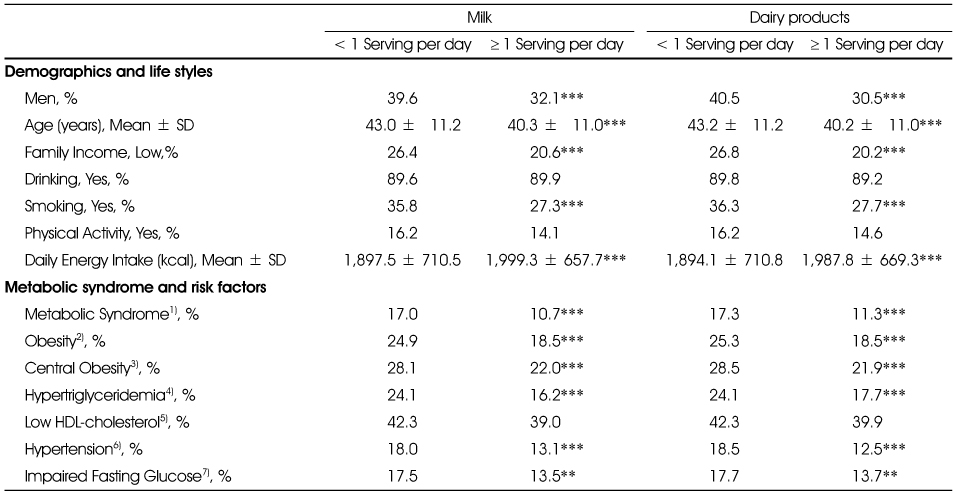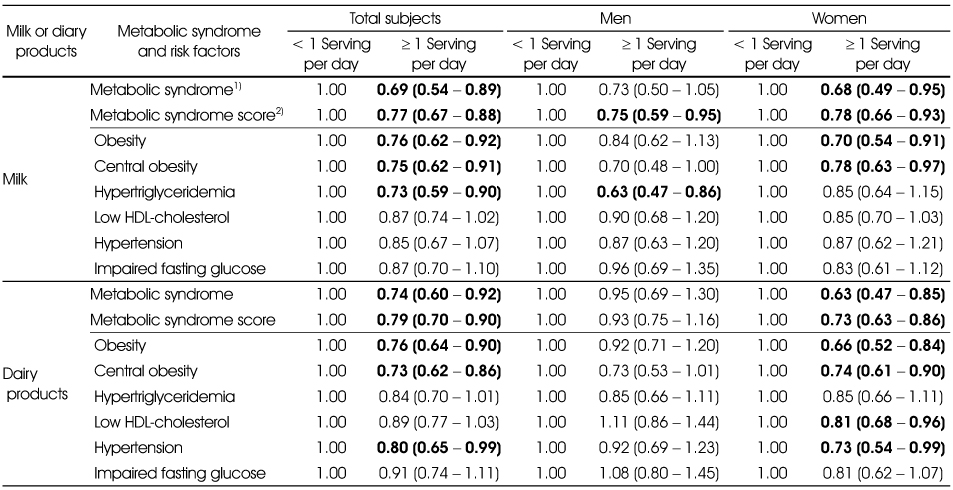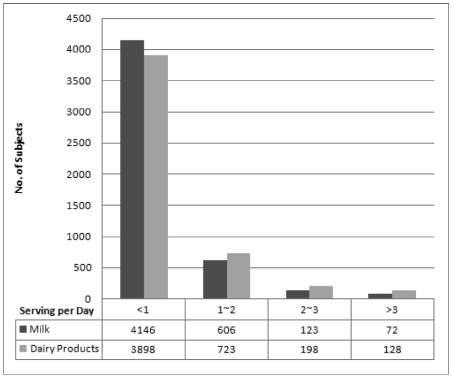Articles
- Page Path
- HOME > Korean J Community Nutr > Volume 17(6); 2012 > Article
-
Original Article
- Milk Intake is Associated with Metabolic Syndrome: Using Data from the Korea National Health and Nutrition Examination Survey 2007~2010
- Chang Jin Lee, Hyojee Joung
-
Korean Journal of Community Nutrition 2012;17(6):795-804.
DOI: https://doi.org/10.5720/kjcn.2012.17.6.795
Published online: December 31, 2012
Graduate School of Public Health, Seoul National University, Korea.
- Corresponding author: Hyojee Joung, Graduate School of Public Health, Seoul National University, Daehak-dong, Gwanak-gu, Seoul 151-742, Korea. Tel: (02) 880-2716, Fax: (02) 762-9105, hjjoung@snu.ac.kr
Copyright © 2012 The Korean Society of Community Nutrition
- 913 Views
- 0 Download
- 25 Crossref
Abstract
- This study aimed to examine associations between milk intake and metabolic syndrome. The subjects included 1,928 males and 3,103 females, aged 19 to 64 years, from the data of 'The Korean National Health and Nutrition Survey 2007-2010'. Daily intake of milk and dairy products was obtained by a 24 hour dietary recall method and divided into two categories by equivalent weight of one serving. The average individual intakes of milk and dairy products were 59.4 g and 74.1 g per day respectively. Milk intake was inversely associated with metabolic syndrome (OR: 0.69, 95% CI: 0.54~0.89), central obesity (OR: 0.75, 95% CI: 0.62~0.91), and hypertriglyceridemia (OR: 0.73, 95% CI: 0.59~0.90). The total intake of dairy products was also inversely associated with metabolic syndrome (OR: 0.74, 95% CI 0.60~0.92), central obesity (OR: 0.73, 95% CI: 0.62~0.86), hypertension (OR: 0.80, 95% CI: 0.65~0.99). The association between intakes of milk and dairy products and metabolic syndrome was significant in women, but not in men. These results indicate that increased consumption of milk and its products is associated with a reduced likelihood of metabolic syndrome and metabolic syndrome risk factors. Further research on causal relationship and dose-response association between milk intake and metabolic syndrome risk is necessary prior to applying the observed results in nutrition policies and programs to prevent the metabolic syndrome.
- 1. Astrup A, Dyerberg J, Elwood P, Hermansen K, Hu FB, Jakobsen MU, Kok FJ, Krauss RM, Lecerf JM, LeGrand P, Nestel P, Riserus U, Sanders T, Sinclair A, Stender S, Tholstrup T, Willett WC. The role of reducing intakes of saturated fat in the prevention of cardiovascular disease: where does the evidence stand in 2010? Am J Clin Nutr. 2011; 93: 684-688.ArticlePubMedPMC
- 2. Berkey CS, Rockett HRH, Willett WC, Colditz GA. Milk, dairy fat, dietary calcium, and weight gain. Arch Pediatr Adolesc Med. 2005; 159: 543-550.ArticlePubMed
- 3. Biong AS, Veireod MB, Ringstad J, Thelle DS, Pedersen JI. Intake of milk fat, reflected in adipose tissue fatty acids and risk of myocardial infarction: a case-control study. Eur J Clin Nutr. 2006; 60: 236-244.ArticlePubMedPDF
- 4. Dallongeville J, Cottel D, Ferrires J, Arveiler D, Bingham A, Ruidavets JB, Haas B, Ducimetire P, Amouyel P. Household income is associated with the risk of metabolic syndrome in a sex-specific manner. Diabetes Care. 2005; 28: 409-415.ArticlePubMedPDF
- 5. Expert Panel on Detection, Evaluation, And Treatment of High Blood Cholesterol In Adults. Executive summary of the third report of the National Cholesterol Education Program (NCEP) Expert Panel on Detection, Evaluation, And Treatment of High Blood Cholesterol In Adults (Adult Treatment Panel III). JAMA. 2001; 285: 2486-2497.ArticlePubMed
- 6. Food and Agriculture Organization of the United Nations. The state of food and agriculture-livestock in the balance. 2009; cited 2012 Aug 29. Available from http://www.fao.org/docrep/012/i0680e/i0680e.pdf.
- 7. German JB, Dillard CJ. Saturated Fats: A perspective from lactation and milk composition. Lipids. 2010; 45: 915-923.ArticlePubMedPMCPDF
- 8. German JB, Gibson RA, Krauss RM, Nestel P, Lamarche B, van Staveren WA, Steijns JM, de Groot L, Lock AL, Destailats F. A reappraisal of the impact of dairy foods and milk fat on cardiovascular disease risk. Eur J Nutr. 2009; 48: 191-203.ArticlePubMedPMC
- 9. Gibson RA. Milk fat and health consequences. Nestle Nutr Workshop Ser Pediatr Program. 2011; 67: 197-207.ArticlePubMed
- 10. Johnson LW, Weinstock RS. The metabolic syndrome: concepts and controversy. Mayo Clin Proc. 2006; 81(12): 1615-1620.ArticlePubMed
- 11. Kang HM, Kim DJ. Gender differences in the association of socioeconomic status with metabolic syndrome in middle-aged Koreans. Korean J Med. 2012; 82: 569-575.Article
- 12. Kang M, Joung H, Lim JH, Lee YS, Song YJ. Secular trend in dietary patterns in a Korean adult population, using the 1998, 2001, and 2005 Korean National Health and Nutrition Examination Survey. Korean J Nutr. 2011; 44(2): 152-161.Article
- 13. Korea Centers for Disease Control and Prevention. Korean National Health and Nutrition Examination Survey. 2010; cited 2012 Aug 29. Available from http://knhanes.cdc.go.kr.
- 14. The Korean Nutrition Society. Dietary reference intakes for Koreans (KDRIs). 2005; Seoul: Kukjin Company; 73-95. 232-244. 337-353. 524-547.
- 15. Lawlor DA, Ebrahim S, Timpson N, Smith GD. Avoiding milk is associated with a reduced risk of insulin resistance and the metabolic syndrome: findings from the British women's heart and health Study. Diabet Med. 2005; 22: 808-811.ArticlePubMed
- 16. Loucks EB, Magnusson KT, Cook S, Rehkopf DH, Ford ES, Berkman LF. Socioeconomic position and the metabolic syndrome in early, middle, and late life: evidence from NHANES 1999-2002. Ann Epidemiol. 2007; 17: 782-790.ArticlePubMed
- 17. Lim S, Lee EJ, Koo BK, Cho SI, Park KS, Jang HC, Kim SY, Lee HK. Increasing trends of metabolic syndrome in Korea - based on Korean National Health and Nutrition Examination Surveys. J Korean Diabetes Assoc. 2005; 29: 432-439.
- 18. Marques-Vidal P, Goncalves A, Dias CM. Milk intake is inversely related to obesity in men and in young women: data from the Portuguese Health Interview Survey 1998-1999. Int J Obes (Lond). 2006; 30: 88-98.ArticlePubMedPDF
- 19. Ministry of Health and Welfare. Dietary guidelines for Korean adults. 2008; cited 2012 Aug 29. Available from http://www.mw.go.kr.
- 20. Paik HY, Kim CI, Moon HK, Yoon JS, Joung HJ, Shim JE, Jung HJ. 2008 Dietary goals and dietary guidelines for Korean adults. Korean J Nutr. 2008; 41(8): 887-899.
- 21. Pereira MA, Jacobs DR, Horn LV, Slattery ML, Kartashow AI, Ludwig DS. Dairy consumption, obesity, and the insulin resistance syndrome in Young Adults. JAMA. 2002; 287(16): 2081-2089.ArticlePubMed
- 22. Pfeuffer M, Schrezenmeir J. Milk and the metabolic syndrome. Obes Rev. 2007; 8: 109-118.Article
- 23. Rosell M, Johansson G, Berglund L, Vessby B, de Faire U, Hellénius ML. Associations between the intake of dairy fat and calcium and abdominal obesity. Int J Obes Relat Metab Disord. 2004; 28: 1427-1434.ArticlePubMedPDF
- 24. Rural Development Administration. Food Composition Table 8th Edition. 2012; Available from http://koreanfood.rda.go.kr/fct/FctFoodSrch.aspx.
- 25. Tremblay A, Gilbert J. Milk Products, insulin resistance syndrome and type 2 diatebes. J Am Coll Nutr. 2009; 28(1): 91S-102S.PubMed
- 26. United States Department of Agriculture. Dietary guidelines for Americans, 2010. 2011; cited 2012 June 29. Available from http://www.cnpp.usda.gov/dietaryguidelinesl.htm.
- 27. Warensjo E, Jansson JH, Berglund L, Boman K, Ahren B, Weinehall L, Lindahl B, Hallmans G, Vessby B. Estimated intake of milk fat is negatively associated with cardiovascular risk factors and does not increase the risk of a first acute myocardial infarction. A prospective case-control study. Br J Nutr. 2004; 91: 635-642.ArticlePubMed
REFERENCES

See Table 1 for definitions of demographic and life style variables
1) Presence of at least three among the five metabolic risk factors (NCEP ATP III 2001 definition)
2) Body mass index ≥ 25kg/m2
3) Waist circumference ≥ 90 cm(man), ≥ 80 cm (woman)
4) Fasting plasma triacylglycerol ≥ 150 mg/dL
5) Fasting plasma HDL-cholesterol < 40 mg/dL (man), < 50 mg/dL (woman)
6) Blood pressure ≥ 130/85 mmHg
7) Fasting plasma glucose ≥ 100 mg/dL
**: p < 0.01, ***: p < 0.001 by χ2-test or Wilcoxon rank sum test

See Table 2 for definitions of metabolic syndrome and risk factors
Confounding variables include age, sex, family income, smoking, drinking and daily energy intake
1) Odds ratio and 95% CI were obtained using binary logistic regression
2) The number of metabolic syndrome risk factors, Odds ratio and 95% CI were obtained using ordinal logistic regression

See Table 3 for definitions of variables.
Confounding variables include age, sex, family income, smoking, drinking and daily energy intake
Figure & Data
REFERENCES
Citations

- Effects of a nutrition education program on metabolic syndrome risk factors in middleaged Korean adults: an intervention study
Minji Kang, Young-Hee Park, Subeen Kim, Eunyoung Tak, Hyun Wook Baik, Hee Young Paik, Hyojee Joung
Korean Journal of Community Nutrition.2024; 29(4): 265. CrossRef - Intakes of Dairy and Soy Products and 10-Year Coronary Heart Disease Risk in Korean Adults
Sinwoo Hwang, Ae Wha Ha
Nutrients.2024; 16(17): 2959. CrossRef - Evaluation of Dietary Nutrient Intake and Food Variety by Milk Consumption in Postmenopausal Korean Women: Data Based on the Korea National Health and Nutrition Examination Survey 2013~2015
Ae Wha Ha, Woo Kyung Kim, Sun Hyo Kim
Journal of the Korean Society of Food Science and Nutrition.2022; 51(9): 912. CrossRef - Inverse association of improved adherence to dietary guidelines with metabolic syndrome: the Seoul Metabolic Syndrome Management program
Dongwoo Ham, YoungYun Cho, Mi-Suk Park, Yun-Sug Park, Sun-Young Kim, Hye-Min Seol, Yoo Mi Park, Sunok Woo, Hyojee Joung, Do-Sun Lim
Nutrition Research and Practice.2020; 14(6): 621. CrossRef - Association between dairy product intake and hypertriglyceridemia in Korean adults
Seon-Joo Park, Junghyun Park, Hong Ji Song, Chang-Ho Lee, Hae-Jeung Lee
Nutrition Research and Practice.2020; 14(2): 152. CrossRef - Biochemical Characteristics and Dietary Intake according to the Frequency of Milk Consumption in Korean Adolescents: Data from the 2010~2011 Korea National Health and Nutrition Examination Survey
Ji Hyun Kim, Sook-Bae Kim
Korean Journal of Community Nutrition.2020; 25(6): 485. CrossRef - Association of total dietary antioxidant capacity with oxidative stress and metabolic markers among patients with metabolic syndrome
Dongwoo Ham, Shinyoung Jun, Minji Kang, Sangah Shin, Gyung-Ah Wie, Hyun Wook Baik, Hyojee Joung
Journal of Nutrition and Health.2017; 50(3): 246. CrossRef - Study on relationship between milk intake and prevalence rates of chronic diseases in adults based on 5thand 6thKorea National Health and Nutrition Examination Survey data
Sehyug Kwon, Jung-Sug Lee
Journal of Nutrition and Health.2017; 50(2): 158. CrossRef - Association of Metabolic Syndrome with Whole Milk and Low Fat Milk: Using Data from the Korean National Health and Nutrition Examination Survey 2013–2015
Hyun-Chul Moon, Da-Hye Choi, Tae-Young Lee, Taek-Young Kim, Young-In An, Seong-Jee Park, Myung-Chul Jung
Korean Journal of Health Promotion.2017; 17(4): 234. CrossRef - Serum Lipid Levels in Relation to Consumption of Yogurt: The 2012 Korea National Health and Nutrition Examination Survey
Bong-Kyung Seo, Nam-Eun Kim, Kyong-Min Park, Kye-Yeung Park, Hoon-Ki Park, Hwan-Sik Hwang
Korean Journal of Family Medicine.2017; 38(5): 249. CrossRef - Comparison of Diet Quality and Diversity according to Obesity Type among 19-64 year old Korean Adults
Hyae Min Gu, So Yeon Ryu, Jong Park, Mi Ah Han, Yeong Eun Son
Korean Journal of Community Nutrition.2016; 21(6): 545. CrossRef - Dyslipidemia patterns are differentially associated with dietary factors
SuJin Song, Hee Young Paik, Minseon Park, YoonJu Song
Clinical Nutrition.2016; 35(4): 885. CrossRef - Meat and milk intake in the rice-based Korean diet: impact on cancer and metabolic syndrome
Shinyoung Jun, Kyungho Ha, Sangwon Chung, Hyojee Joung
Proceedings of the Nutrition Society.2016; 75(3): 374. CrossRef - Evaluation of Obesity and Nutritional Status by Age among Low-income Women aged over 20 -Using Data from the Fourth Korea National Health and Nutrition Examination Survey-
Hee-Kyung Jang
Journal of the East Asian Society of Dietary Life.2015; 25(2): 246. CrossRef - Low consumption of fruits and dairy foods is associated with metabolic syndrome in Korean adults from outpatient clinics in and near Seoul
SuJin Song, Eun-Kyung Kim, Soyoung Hong, Sangah Shin, YoonJu Song, Hyun Wook Baik, Hyojee Joung, Hee Young Paik
Nutrition Research and Practice.2015; 9(5): 554. CrossRef - Assessment on Dietary Diversity According to Korean Dietary Pattern Score of Korean Adolescents and Children: Using 2007~2013 Korea National Health and Nutrition Examination Survey (KNHANES) Data
Yong-Suk Kwon, Yangsuk Kim
Korean journal of food and cookery science.2015; 31(5): 660. CrossRef - The Association between Dietary Fiber Intake and Prevalence of Metabolic Syndrome in Middle-aged Adults in Gyeonggi Province
You-Sin Lee, Sim-Yeol Lee
Korean Journal of Health Promotion.2015; 15(2): 75. CrossRef - Food Insecurity and Related Risk Factors in the Elderly: Korea National Health and Nutrition Examination Survey 2013 Data
Hye-Sang Lee
Journal of the Korean Dietetic Association.2015; 21(4): 308. CrossRef - Prevalence of Osteoarthritis and Related Risk Factors in the Elderly: Data from the Fifth Korea National Health and Nutrition Examination Survey (KNHANES V), 2010~2012
Hye-Sang Lee
Journal of the Korean Dietetic Association.2014; 20(2): 99. CrossRef - Development of Han-sik Database Utilizing an Expert Focus Group and Assessment of Han-sik Effects on Diet Quality
Minji Kang, Hyun Ju Jung, Hyojee Joung, Jae Eun Shim, Sang Eun Lee, Young-Hee Park, Hee Young Paik
Journal of the Korean Society of Food Culture.2014; 29(1): 9. CrossRef - The Factors Influencing Health-Related Quality of Life in the Elderly: Focused on the General Characteristics, Health Habits, Mental Health, Chronic Diseases, and Nutrient Intake Status: Data from the Fifth Korea National Health and Nutrition Examination
Hye-Sang Lee
Korean Journal of Community Nutrition.2014; 19(5): 479. CrossRef - The effect of high-carbohydrate diet and low-fat diet for the risk factors of metabolic syndrome in Korean adolescents: Using the Korean National Health and Nutrition Examination Surveys (KNHANES) 1998-2009
Mi-Rhan Han, Jeong Hyun Lim, YoonJu Song
Journal of Nutrition and Health.2014; 47(3): 186. CrossRef - Utilization of Korea National Health and Nutrition Examination Survey Database: Estimation of Tomato Consumption and the Risk of Metabolic Syndrome
Eunha Youn, Jean Kyung Paik, Bumsik Kim
Food Engineering Progress.2014; 18(2): 109. CrossRef - An Evaluation of Dietary Habit and Nutritional Status by Household Income in Female Adults over the Age of 20 - Using Data from the Fourth Korea National Health and Nutrition Examination Survey -
Hee-Kyung Jang
The Korean Journal of Food And Nutrition.2014; 27(4): 660. CrossRef - The Specific Food Consumption Pattern and Blood Lipid Profiles of Korean Adults
Youngok Kim
Journal of the Korean Dietetic Association.2013; 19(2): 124. CrossRef
- Figure
- We recommend
- Related articles
-
- The dietary factors associated with sleep duration in postmenopausal middle-aged women: a cross-sectional study using 2019–2023 Korea National Health and Nutrition Examination Survey data
- Analysis of the relationship between sugar intake and cancer prevalence: a cross-sectional study using the 8th Korea National Health and Nutrition Examination Survey
- Trends in growth and nutritional status of Korean toddlers and preschoolers: a cross-sectional study using 2010–2021 Korea National Health and Nutrition Examination Survey data
- Total sugar intake and its contributed foods by age groups in Koreans using the 8th (2019–2021) Korea National Health and Nutrition Examination Survey: a cross-sectional study
- Regional differences in protein intake and protein sources of Korean older adults and their association with metabolic syndrome using the 2016–2019 Korea National Health and Nutrition Examination Surveys: a cross-sectional study


Fig. 1
Fig. 2
Comparison of characteristics between subjects with and without metabolic syndrome
1) Experience of drinking alcohol in lifetime
2) Cigarette smoking more than 5 packs in lifetime
3) 3 times a week for at least 20 minutes of vigorous intensity exercise
*: p < 0.05, **: p < 0.01, ***: p < 0.001 by χ2-test or Wilcoxon rank sum test
Comparison of characteristics between two categories of subjects by dairy intake
See
1) Presence of at least three among the five metabolic risk factors (NCEP ATP III 2001 definition)
2) Body mass index ≥ 25kg/m2
3) Waist circumference ≥ 90 cm(man), ≥ 80 cm (woman)
4) Fasting plasma triacylglycerol ≥ 150 mg/dL
5) Fasting plasma HDL-cholesterol < 40 mg/dL (man), < 50 mg/dL (woman)
6) Blood pressure ≥ 130/85 mmHg
7) Fasting plasma glucose ≥ 100 mg/dL
**: p < 0.01, ***: p < 0.001 by χ2-test or Wilcoxon rank sum test
Odds ratios (95% C.I.) for metabolic syndrome and risk factors according to dairy intakes obtained from 24 hour recall method
See
Confounding variables include age, sex, family income, smoking, drinking and daily energy intake
1) Odds ratio and 95% CI were obtained using binary logistic regression
2) The number of metabolic syndrome risk factors, Odds ratio and 95% CI were obtained using ordinal logistic regression
Odds ratios (95% C.I.) for metabolic syndrome and risk factors according to the frequency of milk intake obtained from food frequency questionnaire method
See
Confounding variables include age, sex, family income, smoking, drinking and daily energy intake
1) Experience of drinking alcohol in lifetime 2) Cigarette smoking more than 5 packs in lifetime 3) 3 times a week for at least 20 minutes of vigorous intensity exercise *: p < 0.05, **: p < 0.01, ***: p < 0.001 by χ2-test or Wilcoxon rank sum test
See 1) Presence of at least three among the five metabolic risk factors (NCEP ATP III 2001 definition) 2) Body mass index ≥ 25kg/m2 3) Waist circumference ≥ 90 cm(man), ≥ 80 cm (woman) 4) Fasting plasma triacylglycerol ≥ 150 mg/dL 5) Fasting plasma HDL-cholesterol < 40 mg/dL (man), < 50 mg/dL (woman) 6) Blood pressure ≥ 130/85 mmHg 7) Fasting plasma glucose ≥ 100 mg/dL **: p < 0.01, ***: p < 0.001 by χ2-test or Wilcoxon rank sum test
See Confounding variables include age, sex, family income, smoking, drinking and daily energy intake 1) Odds ratio and 95% CI were obtained using binary logistic regression 2) The number of metabolic syndrome risk factors, Odds ratio and 95% CI were obtained using ordinal logistic regression
See Confounding variables include age, sex, family income, smoking, drinking and daily energy intake

 KSCN
KSCN



 PubReader
PubReader Cite
Cite


